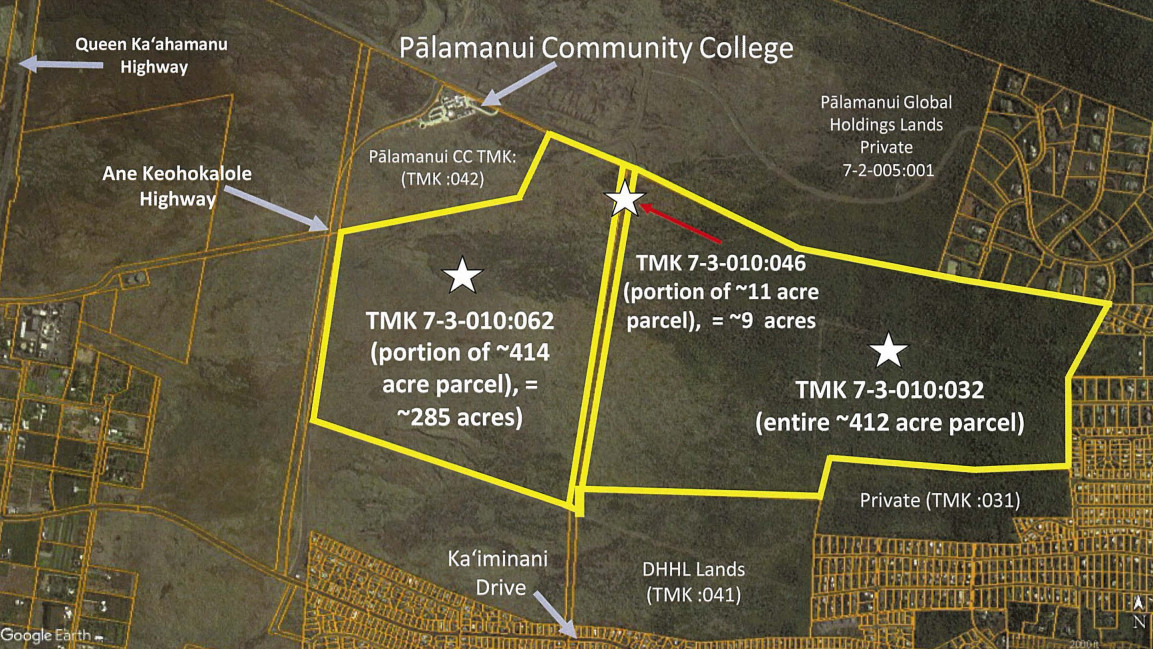(BIVN) – The Hawaiʻi Board of Land and Natural Resources on Friday will consider a proposal for a Pālamanui Campus Reserve in Kona.
The 706 acres of unencumbered lands adjacent to the UH Hawaiʻi Community College Palamanui Campus contain “existing and remnant lowland dry forest, which is a critically endangered ecosystem with less than 5% of its original extent remaining in the Hawaiian Islands”, a State land board submittal states. The University of Hawaiʻi and State of Hawaiʻi Department of Land and Natural Resources Division of Forestry and Wildlife are applying for the Right-of-Entry-Permit, and are seeking authorization for a Memorandum of Understanding (MOU) to collaboratively steward and manage the lands.
From the remarks in the submittal:
Over the past several years, faculty, staff, and students of the UH Palamanui Campus have been identifying rare native trees surrounding the campus and working towards protection of the forest resources of the area. In 2018, the Division of Forestry and Wildlife (DOF AW) and UH Palamanui Campus and Office of Sustainability conducted a site visit to discuss options for protecting the area from natural resource threats, primarily feral goats and wildfire, and the ultimate restoration of this tropical dry land forest.
During this meeting and in following discussions with Land Division, the parties identified the need for collaborative management of the forest, as well as recognized the opportunity to build and support knowledge transfer between the Department of Land and Natural Resources (Department), UH faculty and students, and the surrounding community.
DOFAW seeks to form a partnership with UH to help protect, conserve, and manage the existing and remnant native lowland dry forest and the unique endemic species surrounding the UH Palamanui Campus from threats such as grazing from feral animals and wildfire. DOF AW will provide support and technical expertise in stewarding the lands for these purposes. The subject lands are currently unencumbered and under the Land Division’s management.
The purpose of the MOU is to establish a cooperative agreement to steward the subject lands and support the parties to pursue additional funding and resources to help meet both the conservation and education goals for the Department and UH. The parties intend to collaboratively steward and manage the subject lands to protect the unique and sensitive natural and cultural resources while providing educational and service-learning opportunities for UH students and other groups ranging from school children to continuing education for land managers, natural resource professionals, surrounding community, and the general public. UH seeks to develop and utilize the subject lands as a learning laboratory and place where applied research and vocational learning can occur in the areas of tropical forestry, ecology, hydrology, conservation biology, and natural resource management.
The parties have worked together to draft an MOU, attached as Exhibit 3. The Land Division has no objection to the execution of the MOU, subject to review and approval by the Department of the Attorney General.
Land Division is therefore recommending the issuance of a right-of-entry pe1mit, to DOFAW over the subject lands for lowland dry forest management purposes in collaboration with UH through the MOU. DOFAW and UH will collaboratively steward these significant resources and support each other in building knowledge on the restoration and conservation of this rare forest type.
In written testimony, Hawaiʻi County Planning director Zendo Kern said the County has no objections to the proposal. However, Kern noted that the Land Use Pattern Allocation Guide (LUPAG) of the County’s 2005 General Plan “denotes these parcels for ‘Urban Expansion’. Obviously, this may be inconsistent with public trust duties to preserve critical or endangered habitats. Potentially confounding this may be that the associated Zoning is Agriculture, with minimum 5 acre lot size.”
Kern added that “the proposal also underscores the synergistic nature of the Kona Community Development Plan (KCDP) which calls for masterplans to be developed collaboratively in this area, partially through formal agreements.”


by Big Island Video News11:27 pm
on at
STORY SUMMARY
KONA, Hawaiʻi - The State DLNR and the University of Hawaiʻi want to collaboratively steward and manage the 706 acres of lowland dry forest.